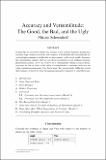Accuracy and Verisimilitude: The Good, The Bad, and the Ugly
Author(s)
Schoenfield, Miriam
DownloadPublished version (762.9Kb)
Publisher Policy
Publisher Policy
Article is made available in accordance with the publisher's policy and may be subject to US copyright law. Please refer to the publisher's site for terms of use.
Terms of use
Metadata
Show full item recordAbstract
It seems like we care about at least two features of our credence function: gradational-accuracy (high credences in truths, low credences in falsehoods) and verisimilitude (in-vesting higher credence in worlds that are more similar to the actual world). Accuracy-first epistemology requires that we care about one feature of our credence function:gradational-accuracy. So if you want to be a verisimilitude-valuing accuracy-firster,you must be able to think of the value of verisimilitude as somehow built into thevalue of gradational-accuracy. Can this be done? In a recent article, Oddie has arguedthat it cannot, at least if we want the accuracy measure to be proper. I argue that it can.
Date issued
2019-08Department
Massachusetts Institute of Technology. Department of Linguistics and PhilosophyJournal
British Journal for the Philosophy of Science
Publisher
Oxford University Press (OUP)
Citation
Schoenfield, Miriam. “Accuracy and Verisimilitude: The Good, The Bad, and the Ugly.” British Journal for the Philosophy of Science (August 2019) © 2019 The Author
Version: Final published version
ISSN
0007-0882